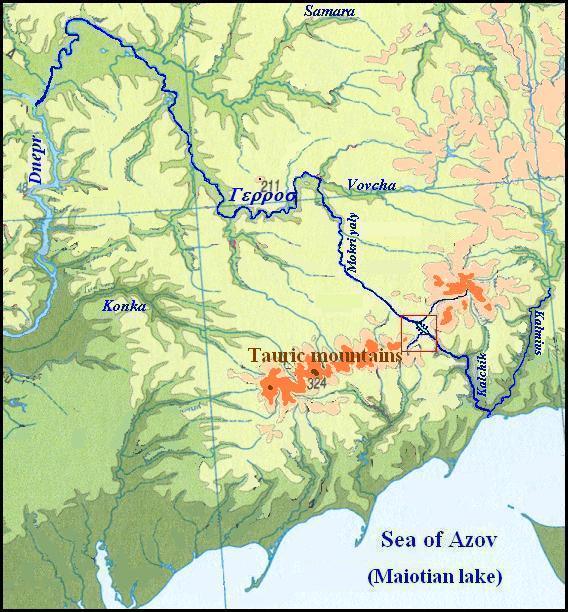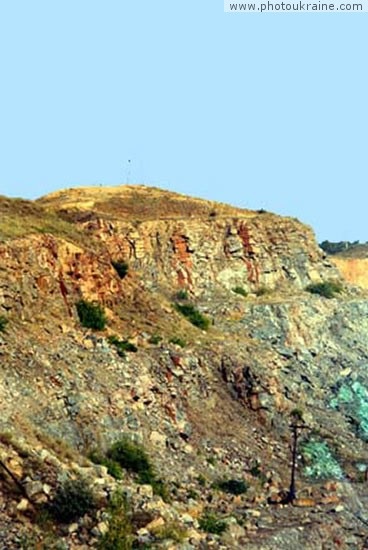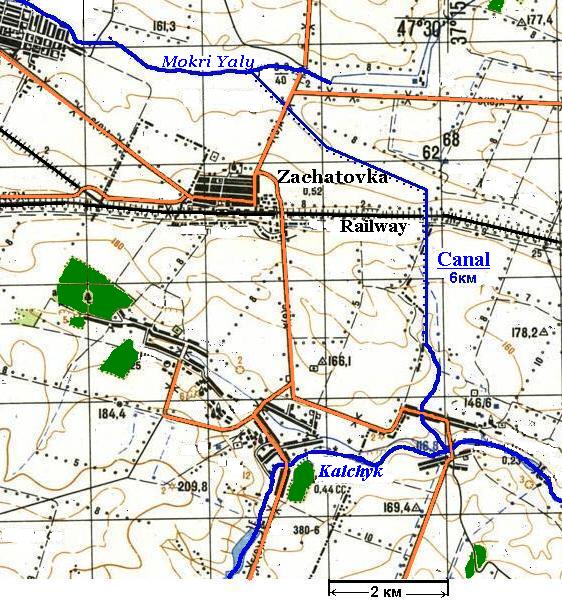The Gerros – the Ancient Water Way from the Dnieper to the Sea of Azov

Herodotus (From the fourth book of the Histories):
3. And first, they (the slaves – V.S.) cut off their land by digging a broad trench extending from the Tauric mountains to the Maiotian lake, at the point where this is broadest;.
In such a way, a water route has been created from the Dnieper to the Sea of Azov, which Herodotus called Gerros:
56. Seventh is the Gerros, which parts off from the Borysthenes near about that part of the country where the Borysthenes ceases to be known,--it parts off, I say, in this region and has the same name which this region itself has, namely Gerros; and as it flows to the sea it borders the country of the nomad and that of the Royal Scythians, and runs out into the Hypakyris.
Obviously, ancient inhabitants of the Azov Sea coast named by the Gerros the waterway has been formed by low currents of the Samara River, the rivers Vovcha, the Mokri Yaly, and the Kalchyk which runs in the Kalmius River near its mouth. The Kalchik River and the Mokri Yaly River come so nearer to each other in one place that, else during rather near historical times, the Zaporozh Cossacks drew their boats from one river to another by land. This fact was described by G. de Bauplan though he wrongly named the Kalchyk as the Miuss River (BAUPLAN de GUILLAUME le VASSEUR, 1998). Closely considering a modern topographical map, one can see that the isthmus, which separates the Mokri Yaly from the small tributary of the Kalchyk, has a distance not more than six kilometers, and both rivers could be connected with a channel so that to form a continuous way from the Sea of Azov up to the Dnieper (See map above). The map shows that a narrow valley goes away from the Mokri Yaly River, it could be a small river in ancient times. Using this valley, it was possible to facilitate the work of hydraulic engineering, though increasing the length of the channel at the same time. Initially, this could just be a quagmire, which could be waded, and this explains the name of this whole waterway "Gerros" as a ford (the language of the Chuvash, distant descendants of the Scythians, has word kěre meaning "a ford").

Left: Belmak-Mohyla, the highest top of Azov Elevation (324 m.)
Herodotus wrote that the Scythians "cut off their land by digging a broad trench extending from the Tauric mountains to the Maiotian lake, at the point where this is broadest". If the Tauric Mountains take as Azov Elevation, what is quite possible according to the appearance of Belmak-Mohyla, the trench would be this channel. Traces of the channel, in principle, can be found fairly easily, but now the isthmus railroad passes (see map below).

Incidentally, the name of the Mokri Yaly River can mean "a waterway," because the Turkic languages have the word jol/joly "a way" and Ukr. mokri means “wet”. If you look Turkic correspondence to the first part of the name, taking words with meaning "water", "wet", we suddenly come to the Kayala River known for the Ipatiev Chronicle. M. Vasmer and K. Menges argue that the correct form of the name is not Kayala but Kayaly (MENGES K.H., 1979: 100). M. Vasmer believed that the name comes from Turk. kajaly "rocky" (VASMER M., 1967: 216), but decryption is unacceptable, because rocks can not be in swampy terrain. K. Menges told about another explanation of the name of the river as qaj + jaly "a river with slippery banks", proposed by M. Sokol, but disputed it, because qaj is "just a verbal basis", while the second part of the word was borrowed by the "Southwest" Turkic languages from modern Greek γιαλοσ "a sea-shore, beach" (MENGES K.H., 1979: 102). This is not so, because the Gagauz and Turkish languages have a word qaj-ğy, where ğy - adjective suffix from the nominal basis (in other Turkic languages "slippery" – tajğy). If we take Turk. joly, turned into jaly in one of the "a-speaking" dialects, we get an explanation of the name of the Kayala River as "a slippery way". Semantically, it is close to the name of "wet way" if our assumption about the existence of wetlands between the Mokri Yaly River and the Kalchik River is true. Especially if there had been drag-way on the wet areas.

